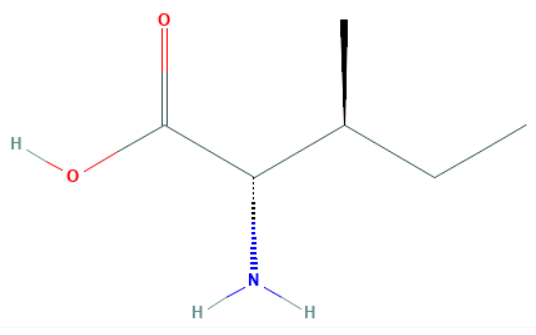
Answer
432.3k+ views
Hint: In terms of molecular weight as well as chemical and physical properties, optical isomerism is a case where the isomers display identical characteristics. They differ in their impact on the rotation of polarized light, however. $ {C_6}{H_{13}}N{O_2} $ is the chemical formula of isoleucine.
Formula Used
We will use the following expression to find the number of optical isomers
$ {2^n} $
Where, $ n $ is the number of chiral centres of the chemical compound.
Complete Step-by-Step Solution
Optical isomerism mainly occurs in substances with the same structural and molecular formula, but cannot be superimposed on each other. We can say, in simple words, that they are mirror images of one another. Alternatively, it can also be found in substances that have an asymmetric carbon atom.
The IUPAC name for isoleucine is $ 2 - $ amino $ 3 - $ methylpentanoic acid.
$ {C_6}{H_{13}}N{O_2} $ is the chemical formula of isoleucine. It has a molecular weight of $ 131.17 {\text{g/mol}} $ .
Let us draw the structure of isoleucine and observe its various properties.

We can observe that there are a total of two chiral centres in isoleucine at the second and third carbon atoms.
Since, there are two chiral centres, we will use our formula to find out the number of optical isomers.
That is
$ {2^n} $
Let us substitute the number of chiral centres in the above formula to get our result
$ {2^2} = 4 $
Hence, there are a total of $ 4 $ optical isomers of isoleucine.
Note
The first step is to find the chiral centres of the molecule in order to come to a solution. It is possible to explain the difference between chiral and achiral molecules on the basis of the symmetry plane. If the entire group attached to the central carbon atom is different, then there is no symmetry plane. A molecule like this is known as a chiral molecule.
Formula Used
We will use the following expression to find the number of optical isomers
$ {2^n} $
Where, $ n $ is the number of chiral centres of the chemical compound.
Complete Step-by-Step Solution
Optical isomerism mainly occurs in substances with the same structural and molecular formula, but cannot be superimposed on each other. We can say, in simple words, that they are mirror images of one another. Alternatively, it can also be found in substances that have an asymmetric carbon atom.
The IUPAC name for isoleucine is $ 2 - $ amino $ 3 - $ methylpentanoic acid.
$ {C_6}{H_{13}}N{O_2} $ is the chemical formula of isoleucine. It has a molecular weight of $ 131.17 {\text{g/mol}} $ .
Let us draw the structure of isoleucine and observe its various properties.

We can observe that there are a total of two chiral centres in isoleucine at the second and third carbon atoms.
Since, there are two chiral centres, we will use our formula to find out the number of optical isomers.
That is
$ {2^n} $
Let us substitute the number of chiral centres in the above formula to get our result
$ {2^2} = 4 $
Hence, there are a total of $ 4 $ optical isomers of isoleucine.
Note
The first step is to find the chiral centres of the molecule in order to come to a solution. It is possible to explain the difference between chiral and achiral molecules on the basis of the symmetry plane. If the entire group attached to the central carbon atom is different, then there is no symmetry plane. A molecule like this is known as a chiral molecule.
Recently Updated Pages
Class 9 Question and Answer - Your Ultimate Solutions Guide

Master Class 9 Maths: Engaging Questions & Answers for Success

Master Class 9 General Knowledge: Engaging Questions & Answers for Success

Class 10 Question and Answer - Your Ultimate Solutions Guide

Master Class 10 Science: Engaging Questions & Answers for Success

Master Class 10 Maths: Engaging Questions & Answers for Success

Trending doubts
Pigmented layer in the eye is called as a Cornea b class 11 biology CBSE

Proton was discovered by A Thomson B Rutherford C Chadwick class 11 chemistry CBSE

What organs are located on the left side of your body class 11 biology CBSE

The lightest gas is A nitrogen B helium C oxygen D class 11 chemistry CBSE

How many squares are there in a chess board A 1296 class 11 maths CBSE

What are ekaboron ekaaluminium and ekasilicon class 11 chemistry CBSE




